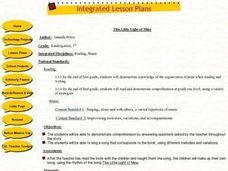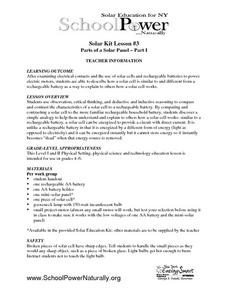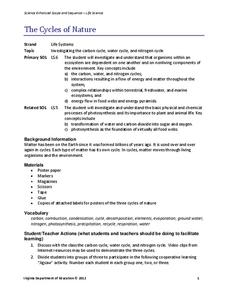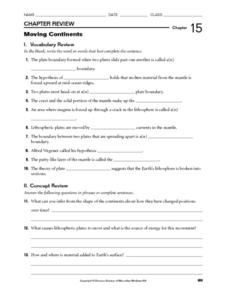Rustle Leaf
Tell Someone About Earth Day
Celebrate Earth Day by spreading the word of conservation. Teach children ten easy ways to help preserve the Earth and share this knowledge with others by sending e-cards and printable cards to loved ones. Extend learning about the...
Curated OER
Design a Bobsled
Students apply their knowledge of friction, drag, mass and gravity as they design, build, and test mini-bobsleds.
Curated OER
The Learning Bottleneck
Students identify and analyze what energy is and how they feel after moving around a lot. They identify other ways that they can acquire heat and if there is some sort of mechanism for storing energy. Finally, students construct their...
Curated OER
Heating
Students develop the idea that heat is a form of energy which moves from hot objects to cold ones.
Curated OER
Webbing out Electricity
Fourth graders identify electricity as a form of energy that is associated with common household products. They utilize technology as an aid in which they can graphically organize their thoughts.
Ocean Explorer
Living with the Heat
Young oceanographers study the Submarine Ring of Fire, which is a series of deep-water volcanic vents that come up from the ocean floor. Learners take a close look at the unique ecosystems that are associated with these areas, how these...
Curated OER
This Little Light of Mine
Elementary schoolers discover how electricity travels and create an electron flow through a closed circuit. They work together to make a closed circuit and observe the electricity being made. This outstanding lesson plan is well worth...
Curated OER
Parts of a Solar Panel-Part I
Students examine electrical contacts, solar cells, and rechargeable batteries and compare and contrast the characteristics of a solar cell to a rechargeable battery in a hands-on activity. Students complete a worksheet as they...
Virginia Department of Education
Predicting Products and Writing Equations
A chemistry lesson plan presents 14 chemical reactions for scholars to observe, write the equation, and balance the equations. Additionally, it provides ways to extend the activity as it relates to catalysts.
Virginia Department of Education
Chemical Bonds
How are chemical bonds similar and how are they different? Provide your young chemists with the resources to more thoroughly understand the concepts of ionic and covalent bonds. Pupils research these topics, diagram examples of each...
Virginia Department of Education
Weather Patterns and Seasonal Changes
Get your class outside to observe their surroundings with a lesson highlighting weather patterns and seasonal changes. First, learners take a weather walk to survey how the weather affects animals, people, plants, and trees during...
Curated OER
ATP in a Molecule
In this cell energy worksheet, students review how ATP is formed and broken down and the uses of cell energy. This worksheet has 8 fill in the blank and 2 short answer questions.
Virginia Department of Education
The Cycles of Nature
Encourage peer collaboration and assist with the creation of visual aids to identify carbon, water, and nitrogen cycles as your class learns more about nature. They discuss relative information, create a visual aid...
Curated OER
Shining the Light on Skin
Students investigate the relationships between certain environmental factors and levels of exposure to sunlight. The variables of location, time of year, and day, and the weather which affect the intensity of the sun are explored in this...
Curated OER
Solar Cell Simulation
Second graders describe how energy moves from the Sun to the photovoltaic cell to the wire and to the load. In this solar cell simulation lesson, 2nd graders demonstrate the movement of photons and electrons to emulate how solar energy...
Curated OER
Recreating the Greenhouse Effect
Learners recreate the greenhouse effect. In this environmental science instructional activity, students gather materials and follow procedures to create the greenhouse effect on a small scale.
Curated OER
Smallest Thing
Students compare characteristics of myobacteria and viruses to determine which is the smallest life form. They read and discuss an article that presents different viewpoints on the definition of life to determine their own viewpoint.
Curated OER
Static Electricity
In this lightning worksheet, students will read information about the different types of lightening and how they are formed. Then students will complete 2 short answer questions.
Curated OER
Pond Ecosystem Field Trip
Students investigate the environment by participating in a class trip. In this pond ecosystem lesson, students define a list of vocabulary terms associated with ponds such as invertebrate and metamorphosis. Students attend a field trip...
Virginia Department of Education
The Law of Conservation of Matter
The Law of Conservation of Matter can be complex for young scientists to fully grasp. Use this experiment to help simplify the process as pupils perform two experiments to determine mass: one that melts a substance and the other that...
Virginia Department of Education
Soap, Slime, and Creative Chromatography
Do you think chromatography paper suffers from separation anxiety? Young chemists make soap, slime, silly putty, and experiment with chromatography in this lesson. The material includes clear instructions for each experiment along with...
Virginia Department of Education
Light and the Electromagnetic Spectrum
Lead your class in a fun-filled team activity that encourages collaboration while learning important concepts. Pupils actively participate in a discussion on the experimental design and the role of mirrors. They perform group activities...
Curated OER
Moving Continents
In this moving continents activity, students review the different types of plate boundaries, what causes earthquakes, and where volcanoes are formed. This activity has 10 fill in the blank and 9 short answer questions.
Virginia Department of Education
Radioactive Decay and Half-Life
Explain the importance of radioactive half-life as your high school biologists demonstrate the concept by performing a series of steps designed to simulate radioactive decay. Pupils use pennies to perform an experiment and gather data....

























